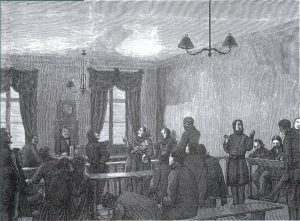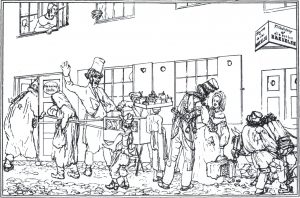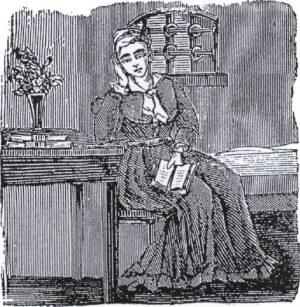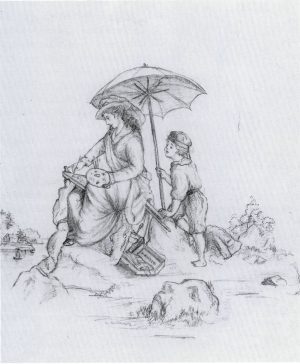From a literary point of view it is easy to dismiss Sophie Sager (1825-1902) as marginal and insignificant. Her production in Swedish is small and was written during a period of only a few years around 1850: a few short pieces and the brief novel Bilder ur lifvet eller Fosterbarnets afslöjade genealogi, Novell (1852; Pictures out of Life or The Revealed Genealogy of the Foster Child, A Novel), all published at the author’s expense. Thereafter, she emigrated to the United States, where she continued her propagandistic work and also published the pamphlet Woman’s Destiny and Man’s Duty (1861).
“Nearly all that she has written is characterised by bombast and a lack of style, which was detrimental to the message that she was preaching”, is the evaluation of Sophie Sager in Svenska män och kvinnor (1949; Swedish Men and Women).

Sophie Sager became known for her statements in a case of assault and battery, in which she was the victim. Like other statements in the case, these were first published in 1848 as a serial in the newspaper Stockholms Dagblad, and in the same year they appeared with a preface and comments by Sophie Sager under the title Sagerska målet (The Sager Case).
It is the way in which she differs from the passive, nice femininity of the time and causes offence through her activities that makes her interesting to us today. Through the story of her life and through her texts we are able to study the development of a female consciousness – how she is initially driven to fight for her own cause, and how at a later point she is roused to extend the fight to the women’s cause in general. We also get an impression of the social situation of many women in Stockholm in that period, as this is reflected in Sagerska målet. We can also see that the rather unschooled author Sophie Sager makes use of literary conventions mainly taken from the popular novels in translation. The chapters in her novel open with mottos in French; the descriptions of the settings follow sentimental patterns; and the novel develops the old and tested theme of love between a noble woman and a man of the people.
The material circumstances of Sophie Sager’s life were the very unstable conditions that characterised the middle class around the middle of the nineteenth century in a society undergoing transformation, from feudalism to capitalism. Her father, an ironmaster, died early; the family went broke; and Sophie Sager’s upbringing and education came to depend on the charity of relatives. In 1848 a relative paid for her travel by steamboat to Stockholm and for her stay there in order to learn fine needlework.

Sophie Sager’s experiences in Stockholm turned her life upside down, drove her onto the public stage, and were the impetus behind her writing career. At first she lived at an inn, which turned out to be an illegal bar with pimping activities.
“[…] I stayed with this horrid creature for a whole week; if I had known of her vices, I wouldn’t have stayed there for one minute; […] she used to lock herself up with one gentleman at a time; that’s when I went out”, it says in Sagerska målet.
After rows and quarrels with the landlady, she was forced to move and managed, thanks to a certain stable manager Möller, to find lodgings with his housekeeper. Soon Sophie Sager discovered that the woman was Möller’s mistress and furthermore that she was engaged in prostitution under the cover of “receiving needlework”. Before long, Sophie Sager also had a nocturnal visit, arranged without her knowledge. The visit was energetically rejected. The stable manager then began a sexual siege of the dismissive Sophie Sager, which ended with attempted rape and assault. She managed to escape and was tended to by a doctor who subsequently helped her report Möller to the police and took care of the medical documentation of her injuries. The long and detailed statements to the court Sophie Sager wrote herself, and she represented herself before the court. The statements were thus the first of Sophie Sager’s writings to be published. They reveal a reality that her contemporary female authors probably never had any personal contact with and did not write about: Stockholm’s nocturnal world of bars, prostitution, and general immorality.
“[…] he hit me again […] and pulled at my head and knocked me against the floor, etc. At that point, he was sure that he would be able to conquer me, but I fought back and tore off a piece of his coat pocket; but he pressed his hands against my breast and mouth so that I could not breathe; […]”, Sophie Sager writes in Sagerske målet.
Sophie Sager’s statements are marked by her strong ambition and desire to receive satisfaction for the offence she had suffered. The offence primarily concerns her right as a woman to reject sexual invitations. Defending one’s innocence was chiefly regarded as a middle-class virtue. That this right could be questioned must be seen in connection with the fact that it was unclear to which social class she belonged, and hence this could be misjudged. This social degradation represented a considerable offence to her. In addition, her adversaries tried to insult her in another way by questioning her trustworthiness – they accused her of being deranged and mendacious.
“[…] these attacks on our honour, which the Royal Police Authority (“Kongl. Poliskammaren”) has allowed a mentally deranged young girl, Sophie Sager, to bring before the Court, without having been able to present any trace of evidence,” it says in J. G. Dillström’s statement in Sagerske målet.
Sagerska målet is an exciting and dramatic text, which can easily and with no prior introduction be read as a work of fiction. It appears to be written in one single associative flow, and the personal voice of the author, an outraged voice speaking up for itself unrestrained by aesthetic or tactical considerations, does itself proud. It is a revealing and highly convincing text, not least because the writer does not come across as completely sympathetic. The formal weaknesses and the absence of any aesthetic standpoint allow the modern reader to sense the writer’s presence in the text:
“[…] I said that he could just kill me; then he said that he would not have to pay for that. It was not until late at night that the struggle ended; but God protected me so that the Fin became the conquered part, for I won; ‘I must suffer for my virtue’, I said to him; ‘I would rather die than commit a crime, for God knows that I am innocent, and He grants the prayers of those who are defenceless’; but I told him that ‘I’ll go to the doctor, who’ll prove that I am not what you are calling me now, because you could not conquer me’.”

The quotation is taken from the description of the last phase of the attempted rape. The woman’s will to preserve her virtue intact is clearly manifested, and her decision to seek satisfaction is prompted by the final insult of her virtue being questioned. A note of triumph rings through the comment “for I won”, and indicates the ambivalence associated with the fact that, on the one hand, the ‘I’ presents herself as an almost weak and defenceless victim, but, on the other hand, she comes across as an active and dynamic person. The reader begins to wonder about the role of the ‘I’ in the events. The fight was not only physical but also verbal. The verbal fight then continues in the statements.
Sophie Sager convinced the court. Möller was convicted of mistreatment, and his appeal to the Svea Court of Appeal was rejected. Both parties submitted new statements with virulent attacks on the other party. Both Sophie Sager and Möller were fined for this.
In a statement to the Svea Court of Appeal, Sophie Sager wrote:
“I have later learned that the stable manager, true to his title, keeps a kind of public riding school on the street of Svenska Prestgatan, and with this in mind I am now able to explain his violent attempts also to domesticate me, for this riding ring of his.”
In this way Sophie Sager made her appearance on the public stage, and from then on she remained there. She was able to make use of her celebrity to provide for herself, for example by giving lectures to paying audiences. The firm belief in the necessity of women’s emancipation had been awakened in her.
“This nationally famous woman really runs the gauntlet of the press in the province of Scania”, the Göteborgs Handels- och Sjöfarts-Tidning (The Gothenburg Journal of Trade and Shipping) comments, on 11 October 1852, in an ironical report on Sager’s public lectures.
In the novel Bilder ur lifvet eller Fosterbarnets afslöjade genealogi, Sophie Sager tries to communicate her message of emancipation in the form of fiction, but it did not turn out to be a felicitous fusion. The need for redress, especially for the injury of social degradation, is also a driving force in this text.
The novel describes the background to a young French noblewoman’s giving birth to a child who at a later point becomes a foster child in Sweden, and it further deals with the adult life of the foster child.
The novel gives the impression of being written in haste, it is uneven and oscillates between different styles. It begins as a sentimental narrative with parodic, Romantic features but is soon watered down, being mixed with realistic episodes, satirical points, emancipation sermons, and travel reports from Copenhagen and Gothenburg. Some of the elements in Sagerska målet have been recast and now apply to the heroine of the novel, the foster child with the tragic French noble ancestry, who is cared for by the iron mill owner Saché (the French pronunciation of ‘Sager’!) and his wife, and who little by little becomes confusingly similar to Sophie Sager herself.
The story is presented by an omniscient narrator who interrupts and comments in confidential conversation with the “emancipated female reader”, whom the author addresses in her foreword. This perspective is to a great extent abandoned in the second half of the novel, where the narration takes the form of letters written by the heroine to a good friend.
The novel boasts three female protagonists: the foster child’s young mother Victoire; the foster child’s friend, the somewhat older Fanny; and the foster child herself, Victoire/Selie Saché. The three women are all motherless, which allows the author to focus upon various patriarchal attitudes towards women.
“She is audacious!” said Leo. “Anyone who writes, however little they write, sets themselves above the judgement of public opinion […].”
“Victoire defies it – and she has to do just that, for public opinion is generally wrong. One should not pay attention to everybody’s thoughts, for then one is left without any of one’s own.”
From Bilder ur lifvet (1852; Pictures out of Life).

The foster child’s mother, Victoire, is torn between a beloved, despotic father and an exacting lover, who threatens to kill himself if she does not stay with him despite her father’s prohibiting this. Faced with this dilemma, she nearly dies of a fever. She recovers and solves her problem through a compromise. She marries her lover in secret and is thereby able to be with him while remaining her unknowing father’s little girl. The father arranges for the lover to be dispatched to the front; Victoire gives birth to a child and dies.
Fanny lives in an ideal relationship with a generous father and a beloved husband. This is Sager’s model marriage; married life is characterised by humour and esteem, and Fanny preaches the gospel of emancipation, with the encouragement of her husband. This is a moderate and innocuous form of emancipation within the framework of the family.
The third woman is Victoire’s daughter and namesake, who as a foster child is called Selie Saché. She is completely without ties, since her foster parents have died as well. She is independent, moves around freely on her own, travels on her own, lectures, writes, allows men to court her, but firmly insists on her virtue. The subtext of the novel appears to be that the destruction of the patriarchal family is a prerequisite for women’s liberation.
In Privata föreläsningar öfver den sanna emancipationen (1852; Private Lectures on the True Emancipation), Sophie Sager clarifies what she understands by emancipation: “A truly emancipated woman […] believes that she, who has been given just as much intelligence as a man by an all-wise Creator, does not need to subject herself to any other constraint than this.”
The lectures are in many ways surprisingly modern, especially as regards the idea that the upbringing of children and the school are meant to produce independently thinking individuals. Matters are brought to a head when she accuses those with political power of deliberately contributing to keeping the people uneducated. She is extremely critical of the way women are trained to be adaptable and pleasant and demands more substance in their education:
“The girl is taught to dissimulate and to comply with what the world says is suitable but is not taught to think rationally, honestly, and to listen to the voice of a pure and spotless conscience. The parents command the child to obey blindly and thereby often do what ought to be – avoided. A woman who is raised in this way must necessarily become prejudiced. It is also a fact that prejudice is more prevalent in Sweden than elsewhere. Prejudices are such ideas that one forms about things in an uninformed way and without investigation, and that one then makes the basis of one’s conclusions and uses as reasons for one’s actions.”
It is an idealistic view of women’s emancipation that Sophie Sager represents, despite her own experience with the insufficient material conditions for women’s liberation. She wants women to emancipate themselves through their own efforts and of their own will, that is, they are to read, think, and speak freely and independently. They are to obey the law and the religious commandments but to ignore superficial conventions. She does not advocate any changes to the law that would benefit women. Her view on marriage is traditional, and she energetically defends female virtue. Her own experience of sexual exploitation undoubtedly contributes to the fact that she so vehemently dissociates herself from what she calls “It-Can-Be-Done relationships” (“går an-förhållanden”).
‘It-Can-Be-Done relationships’, here synonymous with free love between the sexes, is a concept that originated in the debate following upon the publication of C. J. L. Almqvist’s novel Det går an (1839; It Can Be Done!; Eng. tr. Sara Videbeck, 1919; Why Not?, 1994).
It may be argued that Sophie Sager is at her best when she directly pleads her own cause, her own rehabilitation as in Sagerska målet, and women’s liberation in her lectures. It would probably have been to her advantage, if, in her literary work, she had further cultivated her talent for satire and realism. There is a notable contrast between her awkward attempts at adapting herself to the patterns of the period’s popular sentimental novel and her otherwise audacious and unconventional life.
Translated by Pernille Harsting

